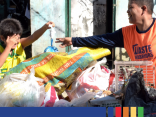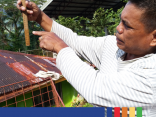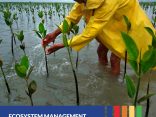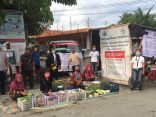To mark the annual National Disaster Consciousness Month, CARE Nederland and its strategic partners in the Philippines[1] carried out in July month-long DRR activities in 36 schools located in high-risk villages across the country. In each school, the various activities were capped by earthquake evacuation drills. By the end of July, a total 6,776 students and 364 teachers have increased their awareness about disasters and have acquired basic emergency preparedness skills such as school contingency planning and conducting evacuation drills.
To mark the annual National Disaster Consciousness Month, CARE Nederland and its strategic partners in the Philippines[1] carried out in July month-long DRR activities in 36 schools located in high-risk villages across the country. In each school, the various activities were capped by earthquake evacuation drills. By the end of July, a total 6,776 students and 364 teachers have increased their awareness about disasters and have acquired basic emergency preparedness skills such as school contingency planning and conducting evacuation drills.
The 36 schools are participating in two complementary DRR projects being implemented by CARE and partners in the Philippines – the Partners for Resilience (PfR) project and the Scale Up, Build Up project (SUBU). PfR is a five-year project being supported by The Netherlands Ministry of Foreign Affairs. SUBU is an 18-month project supported by the European Commission Humanitarian Aid and Civil Protection department’s disaster preparedness programme (DIPECHO).
Although the different schools have different risk profiles, a common general strategy was adopted for all schools. The teachers are trained on Community-Based Disaster Risk Reduction that incorporates Climate Change Adaptation and Ecosystem Management and Restoration. This allowed them to prepare lesson plans that incorporate DRR in regular school subjects such as science and social science. These lesson plans were subsequently implemented by teachers to raise student awareness on how they can reduce their exposure to risks. School Disaster Risk Reduction and Management Committees (SDRRMCs) were also organized. These SDRRMCs carried out risk assessments, and led in the formulation of school contingency plans. The school activities were capped by evacuation drills which served to create increased awareness among students and teachers about the school contingency plan, which includes the school evacuation plan, and to test the effectiveness of the plans.
While a few school heads needed the intervention (through memoranda) of higher education authorities, most school heads and teachers gladly welcomed the DRR activities. “We have limited knowledge about our responsibilities as defined in the new laws about disaster risk reduction and climate change. A Department memorandum also requires us to conduct quarterly evacuation drills. We try to comply with the requirements but we do not even know if we are doing them correctly. We are now confident that we are doing the classroom discussions and the evacuation drills correctly,” said Mr. Michael Pareja, a former teacher in Laminga National Highschool and now the principal of Waloe Highschool in Loreto, Agusan del Sur
Lack of DRR capacity of teachers, location of schools in high-risk areas, and limited participation of school authorities at the subnational level were the key challenges encountered in the course of implementing the month-long activities. However, those on the ground, the teachers, are willing to learn and have already proven that it is possible for them to take the small steps towards resiliency. There is a marked increase in appreciation evident in all areas, summarized by Mrs. Rachel Balacdao, a teacher of Ucab Elementary School in Itogon, Benguet who said “From now on, we will make the conduct of classroom discussions and earthquake drill regular, to ensure that children learn about them and be able to share the knowledge to their families.”
(This article was first published in the CARE DRR Community of Practice, Quarterly Newsletter No 2, September 2013.)
[1] The strategic partners are Agri Aqua Development Cooperation (AADC), Assistance and Cooperation for Community Resilience and Development (ACCORD), Cordillera Disaster Response and Development Services (CORDIS RDS) and Corporate Network for Disaster Response (CNDR)





